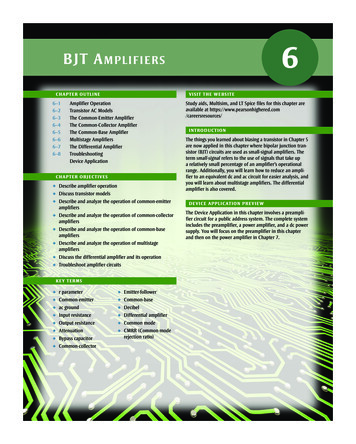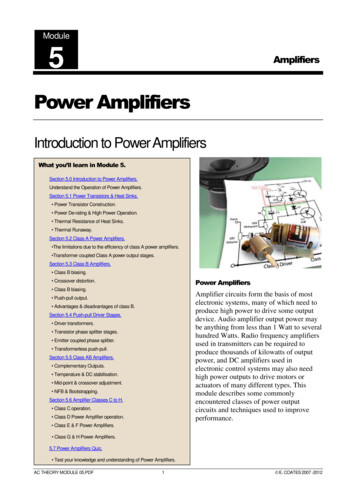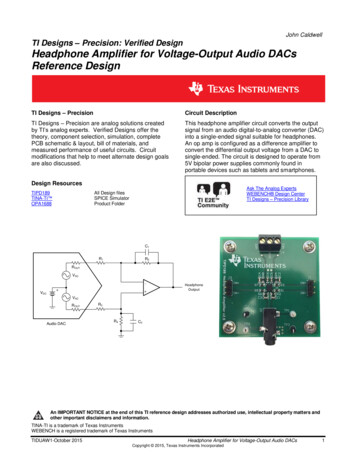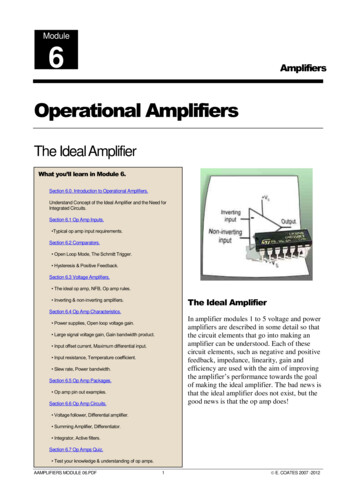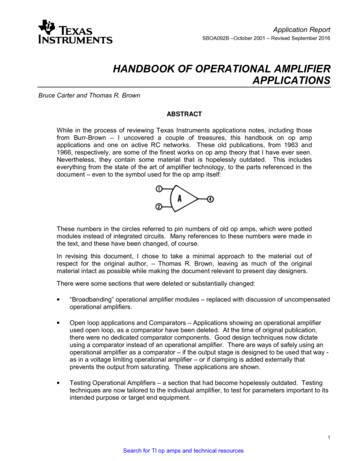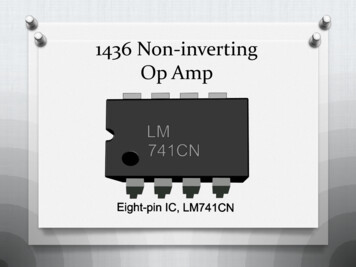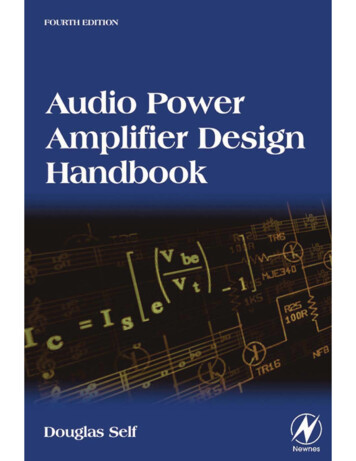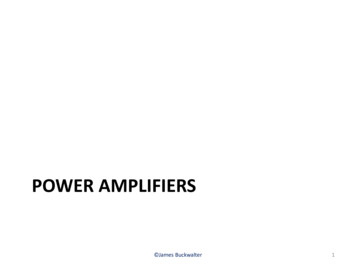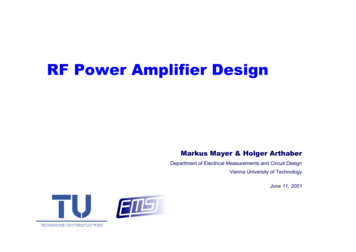
Transcription
RF Power Amplifier DesignMarkus Mayer & Holger ArthaberDepartment of Electrical Measurements and Circuit DesignVienna University of TechnologyJune 11, 2001
Contents Basic Amplifier Conceptsz Class A, B, C, F, hHCAz Linearity Aspectsz Amplifier Example Enhanced Amplifier Conceptsz Feedback, Feedforward, .z Predistortionz LINC, Doherty, EER, .2
Efficiency Definitions Drain Efficiency:POUTηD PDC Power Added Efficiency: η PA POUT PIN η D 1 1 PDC G 3
Ideal FET Input and Output CharacteristicsIDSVGS 0Imgm2VPVP0VGSVGS VP0VKOhmicVDDSaturationVDSmaxVDSBreakdownVDD VKκ VDD4
Maximum Output Power MatchIDSVGS 0Imgm2VPVP0VGSVGS VP0VKOhmicVDDSaturationROPT VDSmaxVDSBreakdownVDS max VKIm5
Class 6
Class A – CircuitVDDGDSRLη D κ 50%G G A (e.g.14 dB)η PA κ 48%7
Class 8
Class 9
Class B and C – CircuitVDDf0GDSRLClass BClass Cη D κ 78%η D 100%G G A - 6dB (8 dB)G 1ηPA κ 65%ηPA 0%10
Influence of Conduction Angle11
Class F (HCA . harmonic controlled pQVDSp2pQ12
hHCA2VPVP(half sinusoidally driven HCA)0IDSIDSImImVGSVGS0VKVDDVDSmaxVDS0p2pQVDSp2pQ13
Class F and hHCA – CircuitVDDZo(n)VDSIDZe(n)0, n eveninf, n evenClass F0, n 1inf, n oddRLhHCAη D κ 100%η D κ 100%G G A - 5dB (9 dB)G G A 1dB (15 dB)ηPA κ 87%ηPA κ 96%14
hHCA – Third Harmonic DSp2pQ15
Third Harmonic Peaking – CircuitVDDGD3f0Sf0RLη D κ 91%G G A 0.6dB (14.6 dB)ηPA κ 87%16
Linearity Aspects17
Linearity Aspects Class A Class AB Class B Class C18
Linearity Aspects Ideal strongly nonlinear model Strong-weak nonlinear model19
Amplifier Design – An Example Balanced Amplifier ConfigurationPort 1Z 50 OhmPort 2Z 50 Ohm20
Amplifier Design – Simulation Gate & Drain WaveformsGate waveforms110000Drain waveforms25Inner Drain Voltage (L, V)AmpInner Drain Current (R, er Gate Voltage (L, V)AmpInner Gate Current (R, mA)Amp-305001000Time (ps)-10001300-505001000-10001300Time (ps)21
Amplifier Design – Simulation Dynamic Load Line & Power SweepDynamic load line8000Power Sweep 1 Tone40IVCurve (mA)IV Curve6000Dynamic Load Line (mA)Amp3080Output Power (L, dBm)Amp70PAE (R)Amp6050400020402000301002010-200000369Voltage (V)12150051015Power (dBm)202422
Amplifier Design – Measurements Single Tone & Two Tone406060 PAE [%]5050404030302020101080 30035PoutGainGammaInPAEP out [dBm], IMDD [dBc], Gain [dB]P out [dBm], Gain [dB]1dBCP350P outIMDDGainPAE005101520253035P in [dBm]23
Amplifier Nonlinearity Gain and Phase depends on Input Signal 3rd Order Gain-Nonlinearities:24
Amplifier Nonlinearity Higher Output Level (close to Saturation) resultsin more Distortion/Nonlinearity25
Nonlinearity leads to? Generation of Harmonics Intermodulation Distortion / Spectral Regrowth SNR (NPR) Degradation Constellation Deformation26
Intermodulation and Harmonics27
Spectral Regrowth10ACPR1 60dBACPR2 60dB0ACPR1 16dBACPR2 43dBrelative power / dB-10-20-30-40-50-60-15-10-505relative frequency / MHz1015 Energy in adjacent Channels ACPR (Adjacent Channel Leakage Power Ratio) increases28
Reduced NPR(Noise Power Ratio) Input Signal Output Signal ofNonlinear Amplifier Degradation of Inband SNR „Noisy“ Constellation29
Constellation Deformation Input Signal Output Signal ofNonlinear Amplifier(with Gain- and Phase-Distortion)30
Modeling of Nonlinearities without Memory-EffectsαarαΘr 2g (r ) z Saleh Model f (r ) 21 βar1 βΘr 2z Taylor Seriesz Blum and Jeruchim Modelz AM/AM- and AM/PM-conversionbetterperformance with Memory-Effectsz Volterra Series ( „Taylor Series with Memory“)31
AM/AM- and AM/PM-Conversion GaAs-PA32
AM/AM- and AM/PM-Conversion LDMOS-PA33
How to preserve Linearity? Backed-Off Operation of PAz Simplest Way to achieve Linearity Linearity improving Conceptsz Predistortionz Feedforwardz .34
How to preserve Efficiency? Efficiency improving Conceptsz Dohertyz Envelope Elimination and Restorationz . Linearity improving Conceptsz Higher Linearity at constant EfficiencyÆ Higher Efficiency at constant Linearity35
Direct (RF) Feedback Classical Method Decrease of Gain Æ Low Efficiency Feedback needs more Bandwidth than Signal Stability Problems at high Bandwidths36
Distortion Feedback Feedback of outband Products only Higher Gain than RF feedback Stability Problems due to Reverse Loop37
Feedforward Overcomes Stability Problem by forward-only Loops Critical to Gain/Phase-Imbalances0.5dB Gain Error Æ -31dB Cancellation2.5 Phase Error Æ -27dB Cancellation Well suited for narrowband application38
baseband inputCartesian FeedbackIOPAsQmodulatorIQmain amp.RF-outputlocaloscillator10IQ AM/AM- andAM/PM-correction High Feedback-Bandwidth Stability Problemsoriginal signalpredistorted signal0relative power / dBdemodulatorUMTS example:-10-20-30-40-50-60-30-20-10010relative frequency / MHz203039
Digital Predistortion Digital Implementation of „Cartesian Feedback“ Additional ADCs, DSP Power, Oversampling needed Loop can be opened Æ no Stability Problems40
Analog Predistortion Predistorter has inverse Function of Amplifier Leads to infinite Bandwidth (!) Hard to realize (accuracy)41
Analog Predistortion Possible Realizations:42
LINC(Linear Amplification by Nonlinear Components)s1(t)s(t)KKs1(t)K(s1(t) s2(t)) Ks(t)signalseparations2(t)KKs2(t)UMTS example:100relative power / dB AM/AM- andAM/PM-correction Digital separation required(accuracy!) High Bandwidth,oversampling necessary Stability guaranteedACPR1 60dBACPR2 60dBs(t)s 1 (t)ACPR1 18dBACPR2 29dB-10-20-30-40-50-60-30-20-10010relative frequency / MHz203043
Doherty Amplifier Auxiliary amplifier supports main amplifier during saturation PAE can be kept high over a 6dB range44
Doherty Amplifier Gain vs. Input Power Efficiency vs. Input PowerPOUTrtyehdoniotaurginfoc2)A1 A(main amp. (A1)aux. amp. (A2)PIN No improvement of AM/AM- and AM/PM-distortion Behavior of auxiliary amplifier very hard (impossible) to realize Stability guaranteed45
EER(Envelope Elimination and Restoration) Separating phase and magnitude information Elimination of AM/AM-distortion Application of high-efficient amplifiers(independent of amplitude distortion) Stability guaranteedamplitude informationRF inputsignalseparationphase informationRF outputhigh efficiencypower amplifier46
EER(Envelope Elimination and Restoration) Analog realizationz Limiter hard to buildz Accuracy problemsz Feedback necessarysupply voltageamplifierpeak detectorlimiterRF inputRF outputpeak detectoramplitude informationdigital baseband input Digital realizationz Oversampling high D/Aconversion rates requiredz High power consumptionof DSP and D/A-convertersz Possible feedbackeliminationz Compensation of AM/PMdistortion possiblehigh efficiencypower amplifiersupply voltage RF outputhigh efficiencypower amplifierphase informationlocal oscillator47
EER(Envelope Elimination and Restoration) Five times (!) oversamplingnecessary to achieve standardrequirements Bandwidth of Magnitude- andphase-signal have higher thantransmit signalUMTS example:UMTS example:1010M agnitudeP hase0-10relative power / dBrelative power / dB0-20-30-40-50-60-30-10full bandwidth3 B 0 bandwidth5 B 0 bandwidth7 B 0 bandwidthACPR1 60dBACPR2 60dBACPR1 33dBACPR2 40dBACPR1 51dBACPR2 36dB-20ACPR1 53dBACPR2 49dB-30-40-50-20-10010relative frequency / M Hz2030-60-30-20-10010relative frequency / MHz203048
Adaptive Bias Varying/Switching of Bias-Voltage depending onInput Power Level Selection of Operating Point with high PAE Applicably for nearly each type of Amplifierpeak detectorbiascontrolRF inputRF outputhigh efficiencypower amplifier49
Adaptive Bias Single tone PAE for switchedVDD with VG kept constant90power added efficiency / %8070605040V D 3.5VV D 4.5VV D 6.5V302032 Simply to implement Concept Stability guaranteed Possible problems:z DC-DC converter with highefficiency necessaryz Possible Linearity Change(can increase and decrease)especially for HCAs3334353637output power / dBm38394050
Summary Digital Realization required to achieve Accuracy Problem of Stability for high Bandwidth Application Higher Bandwidths (Oversampling) necessary,depending on Order of IMD cancellation Predistortion gives best Results while keepingEfficiency high (valid for high Output Levels 40dBm)51
Figure References F. Zavosh et al,“Digital Predistortion Techniques for RF PowerAmplifiers with CDMA Applications”,Microwave Journal, Oct. 1999 Peter B. Kenington,“High-Linearity RF Amplifier Design”,Artech House, 2000 Steve C. Cripps,“RF Power Amplifiers for Wireless Communications”,Artech House, 199952
Contact InformationDI Markus Mayer 43-1-58801-35425 markus.mayer@tuwien.ac.atDI Holger Arthaber 43-1-58801-35420 holger.arthaber@tuwien.ac.at53
RF Power Amplifier Design Markus Mayer & Holger Arthaber Department of Electrical Measurements and Circuit Design Vienna University of Technology June 11, 2001. 2 Contents Basic Amplifier Concepts zClass A, B, C, F, hHCA zLinearit
